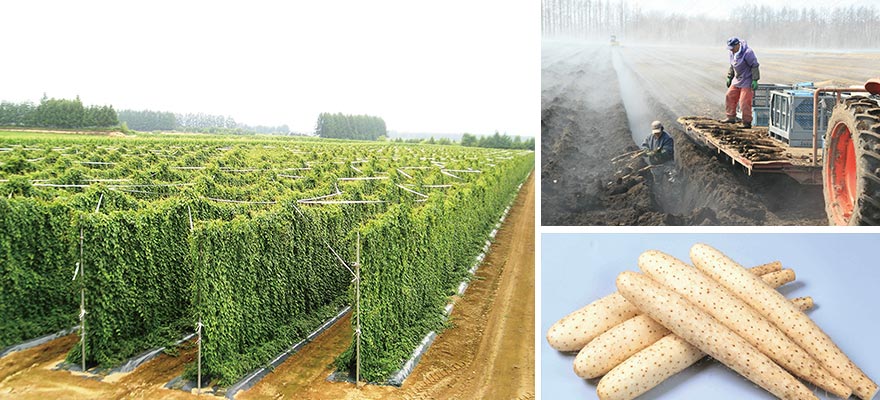Home > Highlighting JAPAN >Highlighting Japan April 2014>Washoku
Highlighting JAPAN
Washoku
Food Valley Tokachi
Hokkaido brand finds international success

Tokachi is a region in southeastern Hokkaido made up of 19 cities, towns and villages, including the city of Obihiro. Situated on the broad Tokachi Plain, the region is among Japan's foremost food production bases, boasting clean air and water, over 2,000 hours of sunshine a year and a cultivated acreage of 39.4 hectares per farmstead (about 18 times the national average). With large-scale farm crops including wheat, beans and potatoes, Tokachi is also home to advanced agricultural research, hosting an agricultural university and a number of agriculture-related businesses and research institutions.
One of Tokachi's leading crops is the Tokachi Kawanishi variety of yam. 21,405 tons of these yams were produced in 2012, with exports reaching a record high of 3,000 tons at a total value of roughly $9 million.
Overseas exports of Tokachi Kawanishi yams began in 1999. "Exports started when plentiful harvests led to a drop in prices," explains Yasuhiro Ikemori, who works in agricultural growth coordination and planning at Obihiro City Hall. Yam production at that time had increased rapidly, resulting in supply vastly exceeding domestic demand, and bringing about a steep decline in prices. Prices had already been trending downward as Japan transitioned to the nuclear family model, with customers moving away from larger yams that smaller families were now unable to finish eating.
Producers sought to adjust domestic prices by exporting their surplus yams to Taiwan. They had discovered that people in Taiwan used these yams in medicinal cooking, referring to them as 'mountain medicine.' Whiter in color and richer in flavor than those grown locally, Tokachi's yams gained a strong following in Taiwan. And while these yams are typically grated and eaten in small quantities in Japan, in Taiwanese cooking they're regularly used in stews, meaning customers there favored the large size that had dropped in value in Japan.
Tokachi growers successfully increased exports year by year, and domestic prices stabilized. Sales were further expanded to the U.S. in 2007, and in 2008 the Kawanishi yam sorting facility became the world's first root-vegetable plant to obtain certification under the HACCP (Hazard Analysis and Critical Control Points) International food sanitation standard. Today, all the region's farmers maintain thorough systems of safety and quality control, carrying out independent initiatives that include: a tracking database for vegetables shipped to local agricultural cooperatives, a Tokachi version of GAP (Good Agricultural Practices) that aims to bring about improvements through checklist-based management of onsite production processes, and voluntary pesticide residue testing.
"Tokachi's unique value will be realized through specialization in safe, secure products," Ikemori explains. "Without specialization, we'll be no different from any other agricultural region." He adds that Tokachi's exports were largely unaffected by the Great East Japan Earthquake in 2011.
Beginning in 2011, Tokachi has been aiming to advance the local economy through promotion of the Food Valley Tokachi philosophy. The concept is aimed at enriching the local economy through three core principles: (1) Producing safe and secure agricultural, forestry and fishery products in Tokachi; (2) providing added value by processing in Tokachi; and (3) expanding sales inside and outside Japan by capitalizing on Tokachi's brand strength. "It all comes down to advancing these three principles and raising the quality of our products," says Makoto Yoshida, who coordinates Food Valley Tokachi projects and communications at Obihiro City Hall. "Through these efforts, we want the people of Tokachi to feel pride and affection for the land on which they live. This is the hope that inspires Food Valley Tokachi."
© 2009 Cabinet Office, Government of Japan






